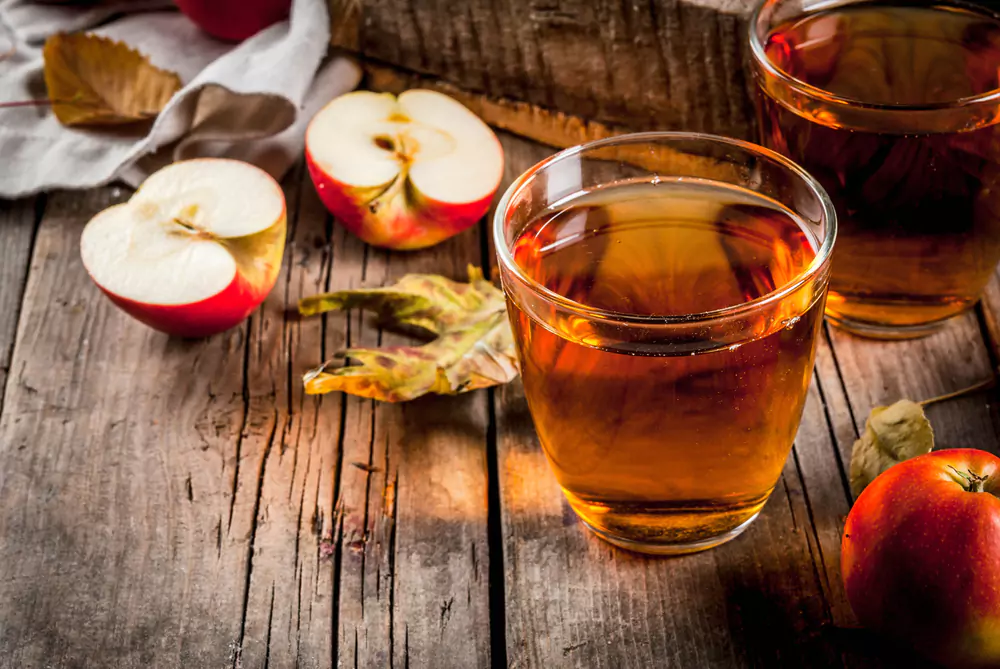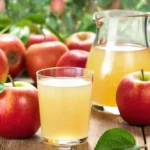When it comes to healthy beverages, apple juice often finds its way into our daily routines. However, many health-conscious individuals wonder if apple juice contains fiber, an essential nutrient known for its numerous health benefits. In this article, we will delve into the question, “Does apple juice have fiber?” and explore the truth behind this popular beverage.
By examining the nutritional composition of apple juice and understanding how it is processed, we can gain a clearer understanding of its fiber content and its potential impact on our overall health.
What Is Apple Juice?

Apple juice is a beverage made from the extraction of liquid from apples. It is typically produced by crushing and pressing apples to extract their juice, filtered to remove any solids or impurities. Apple juice can be consumed as a refreshing drink or used as an ingredient in various recipes and cocktails.
It is known for its sweet and tangy flavor, often enjoyed for its natural sweetness and nutritional benefits. Apple juice can be found in various forms, including fresh-pressed, pasteurized, or concentrated. It is a popular choice among consumers of all ages and is widely available in supermarkets and grocery stores.
Nutritional Content – Apple Juice
| Nutrient | Amount |
| Calories | 46 |
| Total Fat | 0.1g |
| Saturated Fat | 0g |
| Trans Fat | 0g |
| Cholesterol | 0mg |
| Sodium | 1mg |
| Potassium | 105mg |
| Total Carbohydrate | 11.4g |
| Dietary Fiber | 0.2g |
| Sugars | 10.3g |
What Is Fiber?
Fiber, also known as dietary fiber or roughage, is a carbohydrate the human body cannot digest. It is found in plant-based foods such as fruits, vegetables, whole grains, legumes, nuts, and seeds. Fiber is composed of the indigestible parts of plants, mainly cellulose, hemicellulose, and pectin. Unlike other carbohydrates, fiber passes through the digestive system relatively intact and provides no calories or nutrients.
Does Apple Juice Contain Fiber?
Yes, apple juice does contain fiber. However, it is essential to note that the amount of fiber in apple juice is significantly lower than in whole apples. The juicing process removes the majority of the fiber content present in the fruit, leaving behind mainly the liquid and some soluble fiber. While apple juice can still provide some dietary fiber, it is generally recommended to consume whole apples or other high-fiber foods for a more substantial intake of this nutrient.
How Is Apple Juice Made?
To make apple juice, follow these steps:

Selecting Apples
Choose fresh and ripe apples for the best flavor and juice yield. Varieties like Granny Smith, Gala, or Fuji are commonly used for apple juice.
Washing and Preparing
Wash the apples thoroughly to remove any dirt or residue. Remove the stems and any damaged parts of the apples. If desired, you can peel the apples, but it is unnecessary.
Cutting and Coring
Cut the apples into quarters or smaller pieces. Remove the core and seeds from each piece. You can use a knife or an apple corer for this step.
Cooking
Place the apple pieces in a large pot and add enough water to cover them. Bring the water to a boil and then reduce the heat to a simmer. Cook the apples for about 20-30 minutes until they become soft and mushy.
Straining
Once the apples are cooked, allow them to cool slightly before straining. Place a fine-mesh sieve or cheesecloth over a large bowl or pitcher. Pour the cooked apples into the sieve, allowing the juice to strain through while separating the pulp and solids.
Pressing (Optional)
For a higher juice yield, you can press the cooked apples using a fruit press or by wrapping them in cheesecloth and squeezing out the remaining juice.
Sweetening (Optional)
If desired, you can sweeten the apple juice by adding sugar or honey to taste. Stir well until the sweetener is fully dissolved.
Refrigeration
Once strained and sweetened (if desired), refrigerate the apple juice for at least an hour before serving. This will help enhance its flavor and chill it.
Serving
Serve chilled apple juice in glasses or bottles. You can also add ice cubes if desired.
Is Fiber Removed During The Juicing Process?
Yes, during the juicing process, fiber is typically removed from apple juice. Juicing involves extracting the liquid content of fruits and vegetables while separating the pulp and fiber. This results in a smooth and clear juice free from any solid particles.
The removal of fiber allows for easier digestion and absorption of nutrients present in the juice. However, it is essential to note that some juicers may retain a small amount of fiber depending on the specific juicing method.
Different Types Of Fiber
Fiber is a carbohydrate found in plant-based foods that is not easily broken down by the body. There are several types of fiber, each with its unique benefits and functions. Here are some of the main types of fiber:
Soluble Fiber
This fiber dissolves in water and forms a gel-like substance in the digestive system. It can help lower cholesterol levels, control blood sugar levels, and aid in weight loss. Good sources of soluble fiber include oatmeal, barley, nuts, seeds, and fruits (especially apples, blueberries, and pears).
Insoluble Fiber
This fiber does not dissolve in water and passes through the digestive system relatively intact. It helps to add bulk to stool and promote regular bowel movements. Good sources of insoluble fiber include wheat bran, brown rice, vegetables (such as carrots, celery, and potatoes), and whole grains.
Prebiotic Fiber
This type of fiber feeds the good bacteria in the gut, helping to promote a healthy gut microbiome. Good sources of prebiotic fiber include asparagus, bananas, onions, garlic, and whole wheat bread.
Resistant Starch
This type of fiber is a complex carbohydrate not fully digested in the small intestine and is, therefore, considered a fiber. It can help to reduce inflammation, improve insulin sensitivity, and promote weight loss. Good sources of resistant starch include cooked and cooled rice, potatoes, and legumes.
Hemicellulose
This type of fiber is a complex carbohydrate found in plant cell walls that is not fully broken down by the body. It can help to reduce inflammation, improve digestion, and promote weight loss. Good sources of hemicellulose include fruits (such as berries and citrus fruits), vegetables (such as broccoli and cauliflower), and whole grains.
How Much Fiber Is Typically Found In Apples?
The amount of fiber typically found in apples can vary depending on the size and variety of the apple. However, on average, a medium-sized apple (about 182 grams) contains approximately 4.4 grams of dietary fiber. The majority of the fiber in apples is found in the skin, so it is recommended to consume the apple with its skin intact to maximize fiber intake. Fiber is an essential nutrient that aids digestion, promotes satiety, and helps maintain a healthy digestive system.
Fiber Content Of Cold Pressed Vs. Pasteurized Apple Juice
| Parameter | Cold Pressed Apple Juice | Pasteurized Apple Juice |
| Total Dietary Fiber | 1.5-2.5 g/8 oz serving | 1.0-2.0 g/8 oz serving |
| Insoluble Fiber | 0.5-1.5 g/8 oz serving | 0.5-1.0 g/8 oz serving |
| Soluble Fiber | 1.0-2.0 g/8 oz serving | 0.5-1.0 g/8 oz serving |
| Pectin | 0.5-1.0 g/8 oz serving | 0.5-1.0 g/8 oz serving |
| Lignin | 0.2-0.5 g/8 oz serving | 0.2-0.5 g/8 oz serving |
| Other Fibers | 0.5-1.0 g/8 oz serving | 0.5-1.0 g/8 oz serving |
Fiber Content Of Different Apple Varieties
| Apple Variety | Fiber Content (g/100g) |
| Red Delicious | 2.2-2.5 |
| Gala | 2.3-2.6 |
| Fuji | 2.5-2.8 |
| Granny Smith | 2.8-3.2 |
| Golden Delicious | 2.2-2.5 |
| McIntosh | 2.5-3.0 |
| Honeycrisp | 3.0-3.5 |
| Pink Lady | 2.8-3.2 |
| Braeburn | 2.5-3.0 |
Health Benefits Of Dietary Fiber
Dietary fiber is a type of carbohydrate that is found in plant-based foods. Unlike other carbohydrates, fiber cannot be broken down by the body’s digestive enzymes. Instead, it passes through the digestive system largely intact, providing various health benefits.
Here are some of the vital health benefits of dietary fiber:
- Dietary fiber adds bulk to the stool, preventing constipation and promoting regular bowel movements.
- Soluble fiber slows down the absorption of sugar, helping to regulate blood glucose levels and reduce the risk of diabetes.
- Certain fiber types, such as soluble fiber, can bind to cholesterol in the digestive system and help eliminate it from the body, thereby reducing cholesterol levels.
- High-fiber foods are often low in calories and can help promote feelings of fullness, reducing overall calorie intake and supporting weight loss efforts.
- By reducing cholesterol levels, dietary fiber helps lower the risk of heart disease and stroke.
- Fiber acts as a prebiotic, nourishing beneficial gut bacteria and promoting a healthy gut microbiome.
Factors Affecting The Fiber Content In Apple Juice
Several factors can influence the fiber content in apple juice.
Apple Variety
Different apple varieties have varying levels of fiber content. Some apple varieties, such as Granny Smith and Golden Delicious, are known to have higher fiber content compared to others, like Red Delicious or McIntosh. The choice of apple variety used for making apple juice can significantly impact its fiber content.
Processing Method
The process of the apples into juice can affect the fiber content. Traditional methods like pressing and filtering tend to retain more fiber in the juice than modern methods like enzymatic extraction or ultrafiltration, which may result in lower fiber content.
Pulp Content
The presence or absence of pulp in apple juice can also affect its fiber content. Pulp refers to the fibrous material from the apple that is retained in the juice. Apple juices with higher pulp content generally have higher fiber content as well.
Filtering Process
The level of filtration during the production of apple juice can impact its fiber content. Finer filtration processes may remove more of the insoluble dietary fibers present in the juice, resulting in lower fiber content.
Ripeness of Apples
The ripeness of apples used for making juice can influence their fiber content. Riper apples tend to have lower levels of insoluble dietary fibers than less ripe ones. Therefore, using fully ripe apples for juicing may result in slightly lower fiber content.
Comparison Of Fiber Content In Whole Apples And Apple Juice
| Fiber Content (per 100g) | Whole Apples | Apple Juice |
| Total Dietary Fiber | 2.4g | 0.2g |
| Soluble Fiber | 1.2g | 0.1g |
| Insoluble Fiber | 1.2g | 0.1g |
Other Sources Of Dietary Fiber
While fruits, vegetables, and whole grains are commonly known sources of dietary fiber, several other sources can be incorporated into one’s diet to increase fiber intake.
Legumes
Legumes such as lentils, chickpeas, black beans, and kidney beans are excellent sources of dietary fiber. They are not only rich in soluble and insoluble fiber but also provide essential nutrients like protein and minerals.
Nuts and Seeds
Almonds, chia seeds, flaxseeds, and sunflower seeds are nuts and seeds high in dietary fiber. These can be consumed as snacks or added to dishes like salads, smoothies, or baked goods to increase fiber content.
Whole Grains
In addition to the commonly known whole grains like oats, brown rice, and quinoa, other lesser-known options such as amaranth, bulgur wheat, and teff are excellent sources of dietary fiber. These grains can be used as alternatives in various recipes to boost fiber intake.
Tubers
Tubers like sweet potatoes and yams contain a good amount of dietary fiber. Including these in meals can not only provide fiber but also offer other beneficial nutrients like vitamins and minerals.
Berries
Berries such as raspberries, blackberries, and strawberries are not only delicious but also packed with dietary fiber. They can be enjoyed fresh or incorporated into smoothies, yogurt bowls, or desserts for an added fiber boost.
Conclusion
In conclusion, apple juice does not contain significant amounts of fiber. While apples themselves are a good source of dietary fiber, the juicing process removes most of the fiber content from the fruit. This means that commercially available apple juice is generally low in fiber compared to consuming whole apples. However, it is essential to note that some brands may add a small amount of fiber to their apple juice products. Nonetheless, if you are looking to increase your fiber intake, it is recommended to consume whole apples or other high-fiber fruits instead of relying solely on apple juice.
FAQs
Is Apple Juice A Good Source Of Fiber?
No, apple juice is not a good source of fiber. It is primarily made of water and sugar, with very little fiber content.
What Juice Is High In Fiber?
The juice that is high in fiber is prune juice. Prune juice is known for its high fiber content, which can help promote healthy digestion and prevent constipation.
Does Apple Juice Have The Same Amount Of Fiber As An Apple?
No, apple juice does not have the same amount of fiber as an apple. The juicing process removes the majority of the fiber content from the apple, leaving behind mostly the liquid and some nutrients.
Is Apple Juice Good For Diarrhea?
No, apple juice is not recommended for diarrhea as it can worsen the condition due to its high sugar content and potential laxative effect.
Does Apple Juice Make You Poop?
No, apple juice does not directly make you poop. However, it can have a mild laxative effect due to its high water and fiber content, which can help promote regular bowel movements.
Is Apple Juice Bad For You?
No, apple juice is not inherently bad for you. However, it is essential to consume it in moderation as excessive intake can lead to health issues such as weight gain and tooth decay.
How Much Fiber Do You Need A Day?
The recommended daily intake of fiber varies depending on age and gender. However, the general guideline for adults is to consume around 25-30 grams of fiber per day.


![5 Best Ways for Juice Storage - [ Store Fruits & Vegetables Juice ] Juice Storage](https://juicerhunter.com/wp-content/uploads/2024/01/Juice-Storage-150x150.webp)
![Top 10 Apple Juice Brands - [ Updated List 2025 ] Apple Juice Brands](https://juicerhunter.com/wp-content/uploads/2024/01/Apple-Juice-Brands-150x150.webp)


